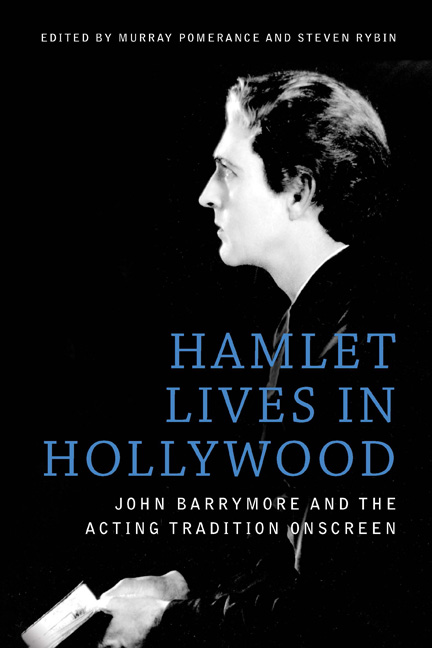Book contents
- Frontmatter
- Contents
- List of Figures
- The Contributors
- Acknowledgments
- Introduction
- 1 The Pre-Bard Stage Career of John Barrymore
- 2 Dangerously Modern: Shakespeare, Voice, and the “New Psychology” in John Barrymore's “Unstable” Characters
- 3 The Curious Case of Sherlock Holmes
- 4 John Barrymore's Introspective Performance in Beau Brummel
- 5 “Keep Back your Pity”: The Wounded Barrymore of The Sea Beast and Moby Dick
- 6 From Rome to Berlin: Barrymore as Romantic Lover
- 7 The Power of Stillness: John Barrymore's Performance in Svengali
- 8 Prospero Unbound: John Barrymore's Theatrical Transformations of Cinema Reality
- 9 A Star is Dead: Barrymore's Anti-Christian Metaperformance
- 10 Handling Time: The Passing of Tradition in A Bill of Divorcement
- 11 John Barrymore's Sparkling Topaze
- 12 “Planes, Motors, Schedules”: Night Flight and the Modernity of John Barrymore
- 13 Barrymore and the Scene of Acting: Gesture, Speech, and the Repression of Cinematic Performance
- 14 “I Never Thought I Should Sink So Low as to Become an Actor”: John Barrymore in Twentieth Century
- 15 Barrymore Does Barrymore: The Performing Self Triumphant in The Great Profile
- Works Cited
- Index
10 - Handling Time: The Passing of Tradition in A Bill of Divorcement
Published online by Cambridge University Press: 23 June 2018
- Frontmatter
- Contents
- List of Figures
- The Contributors
- Acknowledgments
- Introduction
- 1 The Pre-Bard Stage Career of John Barrymore
- 2 Dangerously Modern: Shakespeare, Voice, and the “New Psychology” in John Barrymore's “Unstable” Characters
- 3 The Curious Case of Sherlock Holmes
- 4 John Barrymore's Introspective Performance in Beau Brummel
- 5 “Keep Back your Pity”: The Wounded Barrymore of The Sea Beast and Moby Dick
- 6 From Rome to Berlin: Barrymore as Romantic Lover
- 7 The Power of Stillness: John Barrymore's Performance in Svengali
- 8 Prospero Unbound: John Barrymore's Theatrical Transformations of Cinema Reality
- 9 A Star is Dead: Barrymore's Anti-Christian Metaperformance
- 10 Handling Time: The Passing of Tradition in A Bill of Divorcement
- 11 John Barrymore's Sparkling Topaze
- 12 “Planes, Motors, Schedules”: Night Flight and the Modernity of John Barrymore
- 13 Barrymore and the Scene of Acting: Gesture, Speech, and the Repression of Cinematic Performance
- 14 “I Never Thought I Should Sink So Low as to Become an Actor”: John Barrymore in Twentieth Century
- 15 Barrymore Does Barrymore: The Performing Self Triumphant in The Great Profile
- Works Cited
- Index
Summary
Certainly I believe that ghosts communicate with those who stay on earth. And when I come back, don't stand and gape. Be hospitable to my shade.
John BarrymoreSetting down words to explain Jack Barrymore,” his brother Lionel pointed out, “is like seeking the mystery of Hamlet himself in the monosyllables of basic English” (Kobler, x). Erik Erikson sees the temptation to solve the riddle of Hamlet's “inscrutable nature” as a pointless endeavor if for no other reason than because Hamlet's inscrutability is his nature. Far from explaining his “condition,” Erikson stages the riddle of identity crisis in the play as one that hinges on Hamlet's always being “on the verge of slipping into the state [of madness] he pretends” (Identity 236–7). Unlike the foolish critic, an actor would never attempt to “explain.” Rather, there is, writes Steven Berkoff, a sense that every actor who plays him must take the conundrum of Hamlet “within his own breast,” where “to touch these words is to set alight a small flame within himself,” such that “when you play Hamlet, you play yourself and play the instrument which is you” (vii–viii).
As an “instrument,” John “Jack” Barrymore communicated something vital in his Hamlet. While most contemporary reviews were positive, the overwhelming feeling was that—irrespective of the shortcomings of these nascent performances—his was not just a Hamlet for the new generation but one heralding a historic “turn” in theatrical performance. As Ludwig Lewisohn noted in 1922, Barrymore spoke to his generation in a way they had not been spoken to before. “His bearing and gestures have the restrained but intense expres-siveness of the bearing of modern men who live with their nerves and woes in narrow rooms” (Mills 190). Barrymore, Stark Young remarked (also about the 1922 performance), “seemed to gather together in himself all the Hamlets of his generation, to simplify and direct everyone's theory of the part. To me his Hamlet was the most satisfying that I have ever seen, not yet as a finished creation, but a foundation, a continuous outline.” At its best, Young said, it was like “a fundamental pattern so simple and so revealing that it appeared to be mystical; and so direct and strong that it restored to the dramatic scene its primary truth and magnificence” (Wells 195, 200).
- Type
- Chapter
- Information
- Hamlet Lives in HollywoodJohn Barrymore and the Acting Tradition Onscreen, pp. 123 - 134Publisher: Edinburgh University PressPrint publication year: 2017



